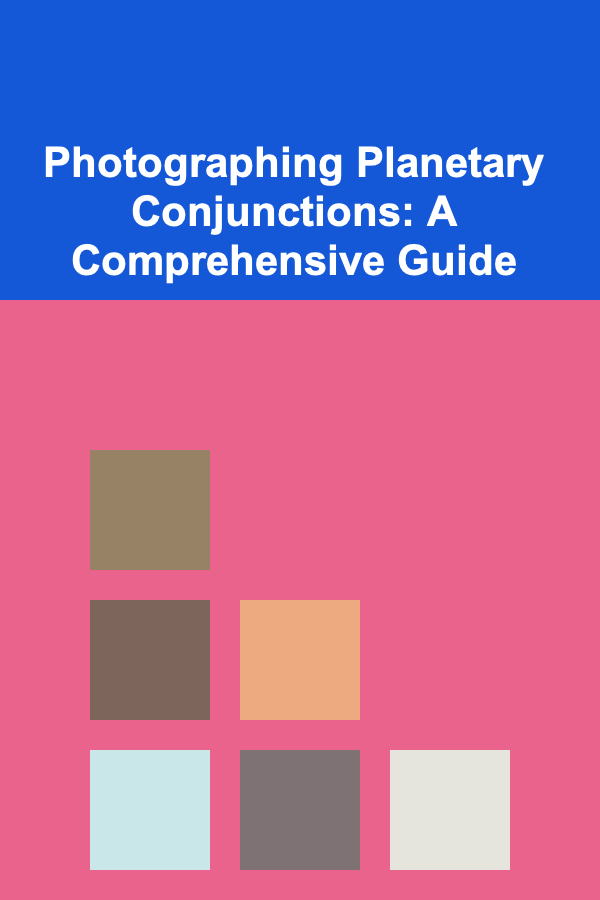
Photographing Planetary Conjunctions: A Comprehensive Guide
ebook include PDF & Audio bundle (Micro Guide)
$12.99$9.99
Limited Time Offer! Order within the next:

Planetary conjunctions, those celestial events where planets appear close together in the night sky, offer stunning visual spectacles and incredible photographic opportunities. Capturing these events requires careful planning, the right equipment, and a good understanding of photographic techniques. This guide provides a comprehensive overview of how to photograph planetary conjunctions, from initial planning to post-processing.
Understanding Planetary Conjunctions
A planetary conjunction occurs when two or more planets appear close to each other as seen from Earth. This is a line-of-sight effect, meaning the planets are not physically close in space but appear to be so from our perspective. The apparent proximity can vary greatly, from a few arcminutes (less than the diameter of the Moon) to several degrees. Conjunctions can involve any combination of planets, including the Moon and bright stars. Understanding the timing and position of these events is crucial for successful photography.
Predicting and Planning for Conjunctions
Several resources can help you predict and plan for upcoming conjunctions:
- Astronomy Apps: Apps like SkySafari, Stellarium Mobile, and PhotoPills provide detailed information about planetary positions, rise/set times, and the timing of conjunctions. They often include augmented reality features that allow you to overlay planetary positions on a live camera view.
- Websites: Websites such as TimeandDate.com, EarthSky.org, and In-The-Sky.org regularly publish information about upcoming astronomical events, including planetary conjunctions. They provide details about the planets involved, their apparent separation, and optimal viewing times.
- Planetarium Software: Desktop planetarium software like Stellarium (free and open source) allows you to simulate the night sky from any location and time, enabling you to precisely plan your shots. You can zoom in on the conjunction, adjust atmospheric conditions, and even simulate different camera fields of view.
When planning, consider the following:
- Date and Time: Identify the precise date and time when the conjunction will be at its closest. Conjunctions often have a window of several days where the planets appear relatively close, but the peak closeness will provide the most visually striking image.
- Location: Choose a location with a clear view of the horizon in the direction of the conjunction. Light pollution can be a major obstacle, so dark sky sites are ideal. Consider foreground elements that can add interest to your composition.
- Elevation: Low-lying conjunctions near the horizon are often affected by atmospheric distortion and light pollution. Elevated locations can provide a clearer view.
- Moon Phase: A bright Moon can wash out fainter planets. Check the Moon phase and plan your shots for nights when the Moon is less prominent or below the horizon.
Tip: Use a planning app to visualize the conjunction from your chosen location. This will help you determine the best viewing angle and time to capture the event. Pay attention to the altitude of the planets above the horizon -- lower altitudes increase the risk of atmospheric distortion.
Equipment Considerations
The equipment you need for photographing planetary conjunctions depends on the desired outcome. Simple wide-field shots can be captured with basic equipment, while detailed close-ups require more specialized gear.
Cameras
- DSLR/Mirrorless Cameras: These cameras offer excellent image quality, manual control, and interchangeable lenses, making them suitable for a wide range of astrophotography. Choose a camera with good low-light performance and a high dynamic range.
- Smartphone Cameras: Modern smartphones are surprisingly capable of capturing planetary conjunctions, especially when used with a tripod and a manual camera app. They are convenient and easy to use, but image quality will be limited compared to dedicated cameras.
- Dedicated Astronomy Cameras: While overkill for simple conjunction shots, dedicated astronomy cameras offer specialized features like cooled sensors and high frame rates, allowing for stacking and advanced image processing techniques.
Lenses
- Wide-Angle Lenses (10-35mm): These lenses are ideal for capturing the conjunction in the context of the surrounding landscape. They allow you to include foreground elements and a broader view of the sky.
- Standard Lenses (50mm): A 50mm lens provides a more natural perspective and can be used to isolate the planets while still including some surrounding sky.
- Telephoto Lenses (70-300mm): Telephoto lenses magnify the planets, allowing you to capture more detail. They are especially useful for conjunctions where the planets are closely spaced.
- Super Telephoto Lenses (400mm+): These lenses offer the highest magnification, revealing details like planetary disks and even faint moons (for very bright planets like Jupiter and Saturn). They require a very stable tripod and careful focusing.
Tripods
A sturdy tripod is essential for long exposures. Choose a tripod that can support the weight of your camera and lens, and that is stable in windy conditions. Consider using a remote shutter release or your camera's self-timer to minimize camera shake.
Accessories
- Remote Shutter Release: Minimizes camera shake during long exposures.
- Dew Heater Strips: Prevent condensation from forming on your lens during cold nights.
- Red Light Headlamp: Preserves your night vision while allowing you to adjust your equipment.
- Extra Batteries: Long exposures can drain your camera's battery quickly.
- Star Tracker: A star tracker compensates for the Earth's rotation, allowing for longer exposures without star trails. This is especially beneficial when using longer focal length lenses.
Tip: Experiment with different lenses to find the focal length that best suits the conjunction and your desired composition. Consider renting a lens if you don't own the ideal focal length.
Camera Settings and Techniques
Proper camera settings are crucial for capturing sharp, well-exposed images of planetary conjunctions. The ideal settings will vary depending on the ambient light, the brightness of the planets, and the lens you are using.
Manual Mode
Use manual mode to have complete control over your camera's settings. This allows you to adjust the aperture, shutter speed, and ISO to achieve the desired exposure.
Aperture
Aperture controls the amount of light entering the lens. A wider aperture (smaller f-number, such as f/2.8 or f/4) allows more light in, resulting in brighter images. However, wider apertures can also result in shallower depth of field, which can make it difficult to keep all the planets in focus, especially with longer lenses. A good starting point is f/4 or f/5.6, adjusting as needed based on the brightness of the planets and the desired depth of field.
Shutter Speed
Shutter speed controls how long the camera's sensor is exposed to light. Longer shutter speeds allow more light in, but can also result in star trails due to the Earth's rotation. The "500 rule" (500 divided by the focal length of your lens) is a guideline for determining the maximum shutter speed before star trails become noticeable. For example, with a 50mm lens, the maximum shutter speed would be approximately 10 seconds (500/50 = 10). However, this rule is just a guideline and may need to be adjusted based on your camera's sensor size and the desired level of detail.
When using a star tracker, you can use much longer shutter speeds without worrying about star trails, allowing you to capture fainter details and lower the ISO.
ISO
ISO controls the sensitivity of your camera's sensor to light. Higher ISO settings allow you to capture brighter images in low-light conditions, but can also introduce noise (graininess) into your images. Start with a low ISO (e.g., ISO 100 or 200) and increase it gradually until you achieve a good exposure, while trying to minimize noise. Modern cameras have excellent noise performance at higher ISOs, but it's still best to keep the ISO as low as possible.
Focusing
Achieving sharp focus is crucial for photographing planetary conjunctions. Autofocus is often unreliable in low-light conditions, so manual focus is recommended.
- Live View Focusing: Use your camera's live view mode and zoom in on a bright star or planet. Adjust the focus ring until the star or planet appears as a sharp, pinpoint of light.
- Focus Peaking: Some cameras offer a focus peaking feature, which highlights areas that are in sharp focus. This can be helpful for fine-tuning your focus.
- Bahtinov Mask: A Bahtinov mask is a diffraction grating that creates a distinct diffraction pattern on bright stars. When the star is perfectly in focus, the diffraction spikes will be symmetrical. This is a very accurate method for achieving critical focus.
Metering
In manual mode, your camera's light meter will serve as a guide, but don't rely on it completely. Take a test shot and review the histogram on your camera's LCD screen. The histogram shows the distribution of tones in your image, from dark to bright. Ideally, you want the histogram to be balanced, with no clipping (loss of detail) in the highlights or shadows. Adjust your aperture, shutter speed, and ISO until you achieve a balanced histogram.
Composition
Composition is key to creating visually appealing images. Consider the following:
- Rule of Thirds: Place the planets along the intersections of an imaginary grid that divides your frame into thirds. This can create a more balanced and dynamic composition.
- Leading Lines: Use natural or artificial lines in the landscape to guide the viewer's eye towards the planets.
- Foreground Elements: Include foreground elements like trees, mountains, or buildings to add context and depth to your image.
- Negative Space: Use negative space (empty space around the planets) to create a sense of scale and isolation.
Capturing Multiple Exposures
Capturing multiple exposures can be useful for creating more dynamic range and reducing noise. This technique involves taking several images with different exposures and then combining them in post-processing.
- Bracketing: Use your camera's bracketing feature to automatically take a series of images with different exposures (e.g., one underexposed, one properly exposed, and one overexposed).
- Stacking: Take multiple images with the same exposure settings and then stack them in post-processing to reduce noise. This technique requires careful alignment of the images.
Tip: Take several test shots and review them carefully on your camera's LCD screen. Pay attention to focus, exposure, and composition. Don't be afraid to experiment with different settings until you find what works best.
Post-Processing
Post-processing is an essential step in creating stunning images of planetary conjunctions. Software like Adobe Photoshop, Lightroom, GIMP (free and open source), and specialized astrophotography software can be used to enhance your images.
Basic Adjustments
- Exposure: Adjust the overall brightness of the image.
- Contrast: Adjust the difference between the highlights and shadows.
- Highlights and Shadows: Recover detail in the highlights and shadows.
- White Balance: Adjust the color temperature to make the image look more natural.
- Clarity and Texture: Enhance detail and sharpness.
- Noise Reduction: Reduce noise without sacrificing detail.
Specific Techniques
- Gradient Removal: Light pollution and atmospheric gradients can create uneven lighting across the sky. Use gradient removal tools to even out the background sky.
- Color Correction: Adjust the colors to make the planets and stars look more vibrant.
- Sharpening: Sharpen the image to enhance detail, but be careful not to over-sharpen.
- Star Reduction: In wide-field images, bright stars can be distracting. Use star reduction tools to minimize the size and brightness of stars.
- Layer Masking: Use layer masking to selectively adjust different areas of the image. For example, you can create a mask to adjust the brightness and contrast of the planets separately from the background sky.
- Combining Exposures: Combine multiple exposures to increase dynamic range and reduce noise. This can be done manually in Photoshop or with specialized HDR software.
- Stacking Images: Use specialized astrophotography software like DeepSkyStacker or Astro Pixel Processor to stack multiple images and reduce noise.
Software Recommendations
- Adobe Photoshop: A powerful image editing software with a wide range of tools for astrophotography.
- Adobe Lightroom: A popular photo editing software for organizing and processing large numbers of images.
- GIMP: A free and open-source image editing software that offers many of the same features as Photoshop.
- DeepSkyStacker: A free software for stacking astrophotography images.
- Astro Pixel Processor: A commercial software for stacking and processing astrophotography images.
- StarTools: A commercial software specifically designed for astrophotography post-processing.
Tip: Post-processing is a subjective process. Experiment with different techniques and software to find what works best for you. Don't be afraid to push the boundaries and create your own unique style.
Advanced Techniques
For those looking to take their planetary conjunction photography to the next level, here are some advanced techniques:
Lucky Imaging
Lucky imaging involves capturing hundreds or even thousands of short-exposure images of a planet and then selecting the sharpest images to stack. This technique takes advantage of brief moments of atmospheric stability to capture high-resolution detail. Specialized astronomy cameras are often used for lucky imaging, as they can capture high frame rates.
High Dynamic Range (HDR) Imaging
HDR imaging involves capturing multiple images with different exposures and then combining them to create a single image with a wider dynamic range. This technique is useful for capturing detail in both the bright planets and the faint background sky.
Using Filters
Specialized filters can be used to enhance specific features of planets. For example, a methane band filter can reveal details in the atmosphere of Jupiter and Saturn. Light pollution filters can help to reduce the effects of light pollution.
Creating Time-Lapses
Create a time-lapse video of the conjunction to show the movement of the planets over time. This requires taking a series of images over a period of hours or even days and then combining them into a video.
Ethical Considerations
As with any type of photography, it's important to be mindful of your impact on the environment and other people when photographing planetary conjunctions.
- Light Pollution: Be aware of light pollution and try to minimize its impact. Use red light headlamps and avoid using bright white lights.
- Trespassing: Respect private property and avoid trespassing. Obtain permission before accessing private land.
- Wildlife: Be mindful of wildlife and avoid disturbing them.
- Leave No Trace: Pack out everything you pack in and leave the site as you found it.
Conclusion
Photographing planetary conjunctions is a rewarding and challenging endeavor. By understanding the basics of planetary motion, choosing the right equipment, mastering camera settings, and utilizing post-processing techniques, you can capture stunning images of these celestial events. Remember to plan ahead, experiment with different settings, and most importantly, have fun! Good luck and clear skies!

How to Find Inner Peace Through Meditation
Read More
How to Scale Your Greeting Card Business and Reach More Customers
Read More
Monetizing Your Deep Learning Expertise with Online Courses
Read More
How to Choose the Right Credit Card
Read MoreHow to Troubleshoot Common Fitness Tracker Issues
Read More
How to Plan Copywriting for Email Marketing Automation
Read MoreOther Products

How to Find Inner Peace Through Meditation
Read More
How to Scale Your Greeting Card Business and Reach More Customers
Read More
Monetizing Your Deep Learning Expertise with Online Courses
Read More
How to Choose the Right Credit Card
Read MoreHow to Troubleshoot Common Fitness Tracker Issues
Read More